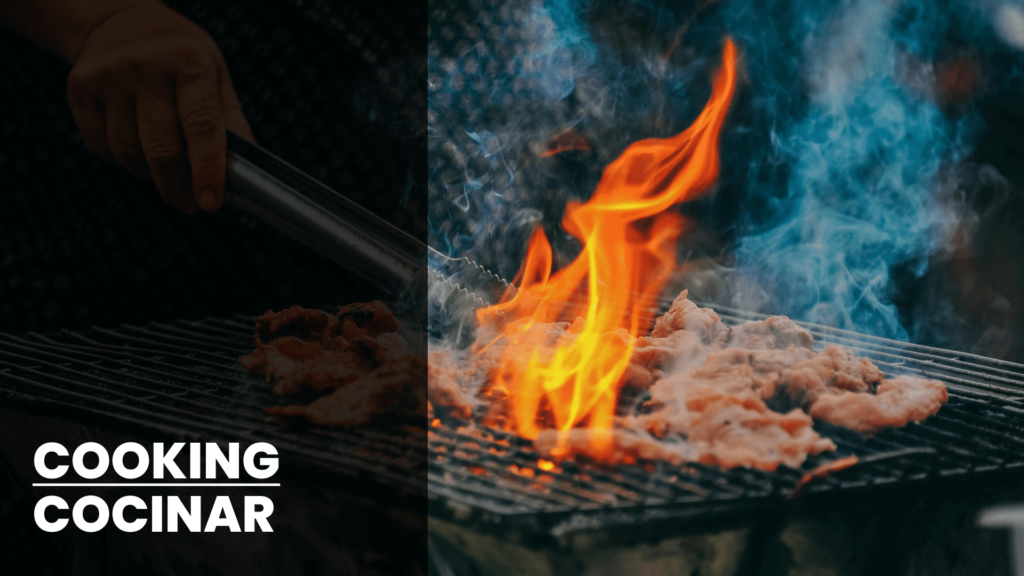
Want to learn Spanish? Try Mondly for FREE now!
Cooking happens every day, so knowing how to talk about it in Spanish is a great way to expand your vocabulary. From reading a recipe to ordering food or sharing your favorite dishes, these words will make conversations about food much easier. So, here are some basic Spanish words you can learn today focusing on cooking methods.
As a Spanish learner myself, I’ve learned the hard way that aiming for fluency right away isn’t the best goal when learning a new language. So, if you’re just starting out with Spanish, I highly recommend familiarizing yourself with the CEFR (Common European Framework of Reference). It will guide you on what to focus on at each stage of your learning journey. Check out this article to get a clearer idea of what you should learn as a beginner and what’s expected of you along the way.
Basic Spanish Words: Common Cooking Methods in Spanish
Here are some basic Spanish words for ways of cooking:
- Hervir (ehr-VEER) – to boil
- Voy a hervir las patatas. (I’m going to boil the potatoes.)
- Freír (fray-EER) – to fry
- Me gusta freír los huevos. (I like to fry eggs.)
- Asar (ah-SAHR) – to roast
- Vamos a asar el pollo en el horno. (We’re going to roast the chicken in the oven.)
- Hornear (or-neh-AHR) – to bake
- Ella va a hornear un pastel. (She’s going to bake a cake.)
- Guisar (gee-SAHR) – to stew
- Mi abuela sabe guisar muy bien. (My grandmother knows how to stew very well.)
- Saltear (sahl-teh-AHR) – to sauté
- Saltea las verduras con un poco de aceite. (Sauté the vegetables with a little oil.)
- Cocer al vapor (koh-SEHR ahl bah-POHR) – to steam
- Prefiero cocer al vapor las verduras. (I prefer to steam the vegetables.)
- A la parrilla (ah lah pah-REE-yah) – grilled
- Me encanta el pescado a la parrilla. (I love grilled fish.)
- Tostar (tohs-TAHR) – to toast
- Voy a tostar el pan para el desayuno. (I’m going to toast the bread for breakfast.)
- Rebozar (reh-boh-SAHR) – to coat in batter
- Vamos a rebozar el pollo antes de freírlo. (We’re going to coat the chicken in batter before frying it.)
Cooking Terms in Context
Now that you know the words, let’s put them into real-life situations. Imagine you’re following a Spanish recipe or giving cooking instructions:
- Primero, hierve el agua y luego añade la pasta.
- (First, boil the water and then add the pasta.)
- Para hacer una tortilla de patatas, primero hay que freír las patatas y la cebolla.
- (To make a Spanish omelet, first, you have to fry the potatoes and onion.)
- Si quieres algo más saludable, puedes cocer las verduras al vapor en lugar de freírlas.
- (If you want something healthier, you can steam the vegetables instead of frying them.)
- El pollo al horno queda muy jugoso si lo cocinas a baja temperatura.
- (Baked chicken turns out very juicy if you cook it at a low temperature.)
Expanding Your Vocabulary
Here are some extra words that might be useful when talking about cooking:
- Aceite (ah-SAY-teh) – oil
- Sartén (sahr-TEN) – pan
- Horno (OR-noh) – oven
- Olla (OY-yah) – pot
- Receta (reh-SEH-tah) – recipe
- Ingredientes (een-greh-dee-EHN-tehs) – ingredients
- Fuego lento (FWEH-go LEHN-toh) – low heat
- Fuego alto (FWEH-go AHL-toh) – high heat
Try Mondly for Free Now!
Want to improve your Spanish as a beginner? I personally recommend Mondly, as it helped me tremendously when I was just starting out. With its interactive lessons and real-world conversations, it’s an excellent tool for expanding your vocabulary and building confidence in Spanish. Try Mondly now for free!
Practice Tip
A great way to remember these words is to think about how you cook at home. Try saying what you’re doing out loud in Spanish:
- Estoy hirviendo el arroz. (I’m boiling the rice.)
- Voy a hornear galletas. (I’m going to bake cookies.)
Little by little, these words will start to feel more natural. Cooking is a fun way to practice Spanish because you can use the words in real life. So next time you’re in the kitchen, try using some Spanish while you cook!


